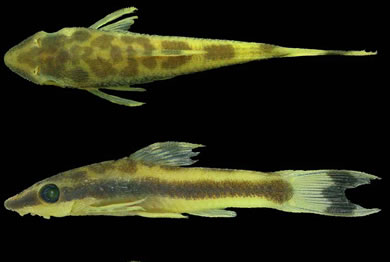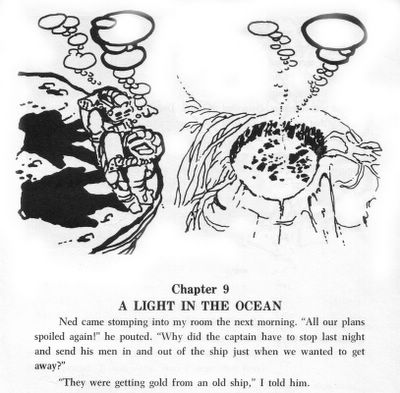Artic Ocean researchers have discovered a new group of microscopic organisms, which they have baptized "picobiliphytes": pico because of their extremely small size, measured in millionths of a meter, bili because they contain biliproteins, highly fluorescent substances that transform light into biomass, and phyte meaning they are plants.
The discovery came from carefully analyzing DNA sequences belonging to vast communities of micro-organisms living in the ocean. "There was one group of sequences that just didn't line up with any of the known groups," explains Dr. Lovejoy. "In fact, the divergence of this group from known organisms is as great as the difference between land plants and animals," adds the scientist. link
Picobiliphytes: A Marine Picoplanktonic Algal Group with Unknown Affinities to Other Eukaryotes. 2006. F. Not et al. Science 315: 253-255.
Picobiliphytes Will Rock You!:
Friday, January 12, 2007
Thursday, January 11, 2007
New Species of Catfish Named After Batman
Ichthyologist Pablo Lehmann, of the Pontificia Universidade Catolica do Rio Grande do Sul, has named the species Otocinclus batmani in a paper in the current volume of the journal Neotropical Ichthyology. It has a dark marking on its tail resembling the Batman logo.

"The name batmani, alludes to Bob Kane's hero Batman of the comic adventures, which had a bat shape for his symbol, referring to the single W- or bat-shaped vertical spot on the caudal fin", wrote Lehmann.
The new species was discovered from the Rio Pure in Colombia and two creeks draining into the Rio Amazonas near Iquitos in Peru. Like other members of the genus, this species is small, with most of the type specimens collected measuring just under 4cm long. link

"The name batmani, alludes to Bob Kane's hero Batman of the comic adventures, which had a bat shape for his symbol, referring to the single W- or bat-shaped vertical spot on the caudal fin", wrote Lehmann.
The new species was discovered from the Rio Pure in Colombia and two creeks draining into the Rio Amazonas near Iquitos in Peru. Like other members of the genus, this species is small, with most of the type specimens collected measuring just under 4cm long. link
Otocinclus batmani, a new species of hypoptopomatine catfish (Siluriformes: Loricariidae) from Colombia and Peru. 2006. P.A. Lehman. Neotropical Ichthyology, 4(4): 379-383.
Wednesday, January 10, 2007
Hypothetical "God Particle" Closer To Discovery
The hypothetical Higgs boson, often dubbed the "God particle", is fundamental to our understanding of the Universe but has yet to be detected.The Higgs boson has been proffered to explain the mystery of why other particles have mass, and forms the missing piece in the puzzle that is the Standard Model - the current theory used to describe the fundamental nature of matter.
For years, researchers have been searching the sub-atomic "soup" created when particles are smashed together in colliders - but no sign of the Higgs has been seen. In obtaining a more precise predicted mass for the Higgs, the particle's existence can be confirmed or ruled out within two to three years, scientists believe.
The calculation has been done by making the finest measurement to date of the mass of another elementary particle, one that is well known, the W boson. The W boson is the carrier of weak nuclear force, one of the fundamental forces in nature, and its mass is believed to be linked to that of the Higgs'.
"And if we don't find it, it is going to be back to the drawing board for particle physics." link
Sunday, January 7, 2007
Belated Birthday Wishes To Tom Bagley


Art © Tom Bagley
Tom's art at Gigposters.com
Tom's music in Forbidden Dimension
Hey, Isn’t that Jackson Phibes himself singing?
Vaughn Bodé’s 20,000 Leagues Under The Sea: Part 6
Back in the 60’s Vaughn Bodé illustrated a number of classics that had been rewritten for “reading challenged” kids. The books were published by Frank E. Richards and sold exclusively to schools.
Because these books are almost impossible to find at reasonable prices I’ll be posting all the illos from the best book of the bunch, “Jules Verne’s ’20,000 Leagues Under The Sea” in eight installments.
Read: Part 1 Part 2 Part 3 Part 4 Part 5 Part 6 Part 7 Part 8
Because these books are almost impossible to find at reasonable prices I’ll be posting all the illos from the best book of the bunch, “Jules Verne’s ’20,000 Leagues Under The Sea” in eight installments.
Read: Part 1 Part 2 Part 3 Part 4 Part 5 Part 6 Part 7 Part 8
All art © the estate of Vaughn Bodé
Saturday, January 6, 2007
Seeing Into The Future With Neural Substrates
Researchers from Washington University in St. Louis have used advanced brain imaging techniques to show that remembering the past and envisioning the future may go hand-in-hand, with each process sparking strikingly similar patterns of activity within precisely the same broad network of brain regions.

"Our findings provide compelling support for the idea that memory and future thought are highly interrelated and help explain why future thought may be impossible without memories."

Link: Neural substrates of envisioning the future. 2006. Karl K. Szpunar et al. PNAS, published online Jan. 3, 2007

"Our findings provide compelling support for the idea that memory and future thought are highly interrelated and help explain why future thought may be impossible without memories."

Dream Girl, Insect Queen, Superboy & LSH © DC Comics
Link: Neural substrates of envisioning the future. 2006. Karl K. Szpunar et al. PNAS, published online Jan. 3, 2007
Friday, January 5, 2007
New Sucker-Footed Bat Discovered In Madagascar
Scientists have discovered a new species of bat, Myzopoda schliemanni, that has large flat adhesive organs, or suckers, attached to its thumbs and hind feet. This is a remarkable find because the new bat belongs to a family of bats endemic to Madagascar--and one that was previously considered to include only one rare species.
Myzopoda are often found in association with broad-leaf plants, most notably Ravenala madagascariensis or the Travelers' Palm, a plant that is endemic to Madagascar but has been introduced to numerous tropical countries. Myzopoda are found in association with such plants because they can use their suckers to climb and adhere to the leaves' flat, slick surface. They are presumed to roost in the leaves during the day. link
Subscribe to:
Posts (Atom)










